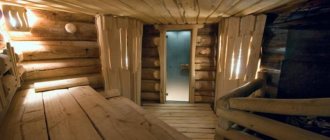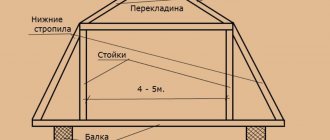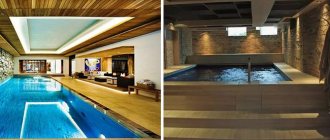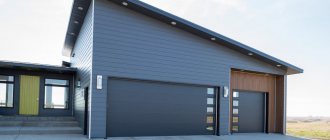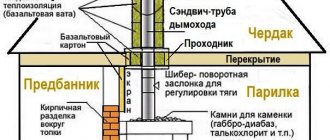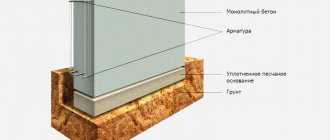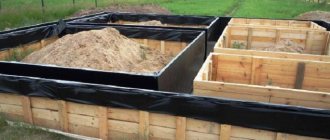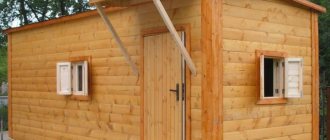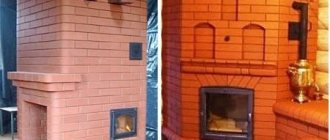In this article we will talk about an additional room no less valuable for a bathhouse than the attic - the basement. Namely, about what can be made from it and how to use it, especially since often a basement already exists only due to the fact that this building was at one time converted into a steam room. We will also talk about many technical subtleties and secrets, knowledge of which will help you make your baths an entire multimedia recreation center!
Yes, you can’t live in a basement all the time - a purely human factor comes into play here, when the lack of sunlight and awareness of being underground has a depressing effect on the psyche. But spending a weekend with friends or family enjoying pleasant bath procedures and watching excellent quality and sound of a movie is quite a pleasant experience. After all, the Russian bathhouse has long been no longer perceived only as a washing or laundry room - now it is a traditional and multifunctional source of recharging for any urban person.
- 2 How to build a bathhouse with a basement?
- 3 Waterproofing and ventilation of the bath basement
- 4 Finishing: breaking the perspective and raising the ceiling
- 5 Why does a bathhouse need a basement? Amazing solutions!
Pros and cons of having a basement in a bathhouse
Let's first understand the terminology. A cellar is a mini-cellar, which is designed for storing vegetables, and is located in a specific place. A basement is a room below ground level, below the first floor. Its purpose can be very different: from storing wine to arranging a living room. But the ground floor is only partly recessed into the ground and is most often used to house a garage.
The very word “basement” already explains that this room is under the shaft, i.e. under the arches. And look what can come of it:
Door installation
It is important to install the correct door in the bathhouse on the ground floor, since it is this that determines high-quality thermal insulation and other qualities. The door can be selected before making a sauna in the basement of your home and it must meet a number of criteria.
It is best to use a material with the following characteristics in its manufacture:
- increased moisture resistance;
- inertness to regular heating;
- resistance to regular temperature fluctuations.
Durable wood or thermal glass is best suited for these purposes. You can also use a combined design that combines both types of material. Anyone thinking about how to build a sauna in the basement of a cottage should understand that the use of metal parts when finishing it is simply unacceptable.
Even the smallest piece of hardware will become hot and during the procedure its use will simply become impossible. Thus, you should simply refuse to use a metal door within a basement with a bathhouse.
As for the aesthetic side of the issue, a competent combination of wood, glass and plastic will create an original door. In the photo and upon visual inspection it will look very presentable.
How to build a bathhouse with a basement?
Building a basement already under a finished bathhouse is quite problematic - it is much easier to plan it even before construction. But everything is possible with desire and patience, of course. Also examine the soil structure before designing such a bathhouse. Indeed, in some areas it will not be possible to build basements at all - dangerous subsoil gases will seep into them. Just order such a geological service from any construction company. After all, even monolithic walls, according to experts, do not have 100% protection from this phenomenon.
Therefore, before designing the bathhouse itself, determine the exact location of its groundwater. Experienced builders do not recommend making the basement floor directly above the water - the minimum distance should be at least 50 cm.
The most economical option for building a basement is to use blocks: quickly and efficiently. Just start laying from the corners, and do not forget about waterproofing - the blocks are afraid of dampness. But the hole needs to be dug to the depth of the walls - the sand cushion should be on the same level with them.
But to arrange a spacious rest room or bathroom under the bathhouse, consider the option of pouring a monolithic foundation, when it smoothly transitions into the base.
Here's how to do it:
- Step 1. Mark the future foundation and dig a trench along it with a depth of two meters (depending on your groundwater level - the groundwater level under the future bathhouse).
- Step 2. Install the formwork in the trench, fill it with reinforcement cage, as well as the floor of the future trench. Add any modern waterproofing component to concrete. In the formwork itself, leave holes for future utilities.
- Step 3. Select soil inside the perimeter, make a dense sand and gravel backfill and install a reinforcement cage.
- Step 4. Fill the new frame with concrete and cover it with a waterproofing layer.
- Step 5. When the basement floor is ready, lay reinforced concrete slabs on the monolithic walls.
Remember that building a basement, even in the driest area, still requires waterproofing. After all, accidental pipe breaks or prolonged rains cannot be predicted, and if you place furniture there, it will be hopelessly damaged before the weekend. There should be no dampness in such a basement at all - after all, it will also create an unpleasant odor that is difficult to remove.
Features of construction on the ground floor
The first step when building a swimming pool in the basement is to dig a pit corresponding to the future size of the artificial reservoir. Naturally, if the pool is located in the basement of a private house, then all excavation work will have to be carried out independently, without the use of special equipment. And this is accompanied by serious physical effort. You will have to not only dig a large hole, but also carry huge volumes of soil outside and dump them somewhere.
Construction of a swimming pool involves a large range of work, so it is better to entrust it to professionals.
In addition, such work of digging a large hole in the basement of a house often leads to problems with the foundation. Especially if the foundation is strip or based on a reinforced concrete slab (owners of a house on a pile foundation, of course, have nothing to worry about). Therefore, the walls of the pit must be carefully strengthened. They should also be located at the maximum distance from the ceilings.
If you don’t want to deal with waterproofing the walls of the pit, thinly building the walls of the pool, or additionally strengthening the bottom of the pit, then you can purchase a large ready-made plastic bowl. But here another problem arises - how to carry this bowl into the basement of a house built a long time ago? If the house is at the initial stage of construction, then such questions, as a rule, do not arise. In addition, some companies offer prefabricated bowls, which is very convenient in our case.
Waterproofing and ventilation of a bathhouse basement
Thus, it is basements that are most susceptible to the negative effects of moisture - here it can penetrate from any direction. Therefore, even walls need waterproofing, for which a whole range of measures is carried out and for which it is necessary to allocate a lot of money and time during the construction process. But, naturally, if you are making the basement under the bathhouse residential, then first of all you need to make it dry.
So, if your bathhouse already has a basement, determine where exactly the moisture comes from:
- Through cracks in the floor and walls.
- On the surface of the walls in the form of condensation.
- From the upper room (for example, above the basement there is a washing room for a bath or steam room).
If the floors in the basement are literally flooded, it means that the groundwater under the bathhouse is too close. Test your fear: dig a small hole and watch it for 24 hours. If it receives abundant water, it is groundwater. They can be kept away from the bathhouse basement using a drainage well with a pump - effective, although costly. The disadvantage of such a system is that soil will also get into the water, which, although not harmful to modern filters, is gradually washed out from under the building itself.
Here's how to set up a drainage system around the basement: dig a small trench around the entire perimeter and lay a pipe wrapped in geotextile in it. This material allows water to pass through, but does not allow clogging dirt or fragments of branches.
And the condensation on the basement walls can be so strong that it forms puddles on the floor, which are safely perceived as moisture leaking from under the floor. But this is a common occurrence in the spring, when too damp air enters through the upper ventilation windows. And, if the basement floor turns out to be cold, streams immediately form on it. That is why high-quality insulation is needed in order to separate warm air from cold walls - this way condensation will never occur, and you don’t have to worry about dampness or mold.
If moisture in the basement appears due to condensation on the walls and floors, it means the ventilation is not organized correctly. To completely waterproof the basement floor from dampness, follow these instructions:
- Step 1. Remove the soil in the basement to a depth of 30 cm, and fill the bottom with a sand cushion up to 15 cm high. Compact the sand well, level it and check that there are no differences in height.
- Step 2. Pour concrete onto the compacted sand in a layer of 10 cm. Level it thoroughly.
- Step 3. Once the concrete is dry, apply hot bitumen to the surface in three layers. Each previous layer must dry well before applying the next one. Bitumen should also go onto the walls.
And then it is important to protect the basement from external dampness:
Of course, the sooner you start waterproofing problem areas, the better, because dampness can destroy walls. So, if these are cracks, then find every single one, fill them, fix the fiberglass reinforcement mesh and fill the entire floor with a layer of concrete. Hide the most problematic areas under hot bitumen - this will be a good barrier. And for problem walls, use coating waterproofing.
In addition to bitumen, today more expensive special compounds are also used, which are quickly absorbed into the surface being treated and immediately crystallize, thereby creating an excellent barrier to moisture. And the most popular today is the method of injection with a water-repellent liquid that saturates the entire thickness of the walls.
You can finally dry the basement after all the work using slaked lime: just leave the filled bucket overnight and pick it up in the morning.
You will be surprised, but it is easier to store vegetables in the cellar than to store furniture in the basement. The fact is that in the cellar there are always some open areas with soil, and the microclimate somehow self-regulates. But the basement is a closed system, and without normal ventilation it disappears. But the norms of SNiP 31-02-2001 are responsible for this. They say that in addition to ventilation exhaust ducts, the underground section must also have a window, at least the size of a small window. The influx of fresh air can be provided by ventilation ducts: for every 10 square meters their area should be at least 0.5 square meters, and they should be in each of the corners.
There should be two pipes in the ventilation system: exhaust and supply. The first one goes from the ceiling to the roof, and the supply one is on the opposite wall and goes from the floor. The first will remove air and cigarette smoke through the roof to the street, and the second will deliver fresh oxygen. Also, a constant optimal temperature is important for a residential basement. To control it, place a thermometer.
Installation of equipment
The equipment is installed according to a finished project. First of all, the equipment is assembled, all threaded and adhesive connections, couplings, taps and other important elements are checked. After the equipment is installed, it is necessary to fill in water and turn on the filters for washing.
If there are no leaks, we can conclude that the installation was completed correctly. Installing special equipment is a rather complicated operation, but you can do it yourself using the instructions. It is best to use the services of specialists to perform installation.
Finishing: breaking perspective and raising the ceiling
As a fairly budget option, compacted clay for walls and floors may be suitable if you can lay it out. Basement walls are most often finished with ceramic tiles, multi-layer plywood or stone. But ideally, for cladding the basement walls, use moisture-resistant plasterboard, which can be mounted on a metal frame. And then - what do you like best: stone or ceramic tiles, plastic panels, special moisture-resistant paints with a rich range or mineral plasters.
If serious mistakes were made in the construction of the basement, you will notice them immediately - damp spots will appear on the plaster. There is one more point: the basement is always the coldest place in the bathhouse. Therefore, its thermal insulation is as important as waterproofing.
Vertical lines on the walls and furniture, which also look stylish, will help to visually raise the ceiling that is usually low in the basement. Also purchase glossy or mirrored stretch ceilings, which also optically expand the volume of the room. Reference: the standard basement height is 1.92-2 meters.
It is convenient to zone the basement with the help of screens and a regular bar counter, but give up podiums and steps - these are traditional attributes of the attic, which has much more under-ceiling space.
The staircase to the basement of the bathhouse itself can also be a wonderful attribute of the interior - today there are so many options available! The main thing is to purchase or build one that does not slip (under bare feet after a steam room), is not steep and has comfortable handrails.
Because There is no natural light in the basement, so in the interior they give preference to light tones of decoration. Even if they don’t harmonize well with the bathhouse style. But it is better not to use green color at all, except in the form of upholstery on a billiard table.
Modern lighting design will also help get rid of the feeling of being in a cave and being enclosed - you can work wonders with it!
Ventilation system
The internal ventilation system is based on natural air movement - warm air, heated in the steam room, rises up and leaves the room, and fresh cool air enters through the hole from below, filling the warm space.
But two holes are not enough for an optimal microclimate. The hood is selected based on the configuration of the room and the overall air ventilation system in the house. these indicators determine the location of the vents and the need to insulate the hood.
The optimal option is to locate the lower flow vent under the stove in the steam room, and the upper one above the shelves, where the hottest air is.
Then the circulation will be done at a meter distance from the floor. If the lower vent is made above the first shelves, then there may be a draft, which will lead to serious heat loss.
Regulations
There are quite a lot of regulations regulating the activities of bath and sauna organizations. The main ones are:
- ZPPP No. 2300-1.
- SanPiN 1.2. 3150-13 (a document regulating both the design and operation of saunas).
- SNiP 31-05-2003 (rules for the construction of housing and communal services).
- SP 118.13330.2012/SNiP 31-06-2009 (requirements for public buildings).
- Federal Law No. 123, pay attention to table 11. This law is a technical regulation of fire safety (fire safety).
- NPB 110-03 (list defining the types of knowledge to be protected by automatic fire extinguishing systems and automatic fire extinguishing systems).
Before starting work, make sure that local authorities have not provided you with a SNiP specially developed for the city or region.
Which heating method should I choose?
Heating a basement or cellar is a rather complicated issue. Here it is necessary to approach the issue of choosing the type of heating of the room as responsibly as possible, based on the wishes and requirements of the owner. For example, if you need to heat the basement in a seasonal home (that is, during the cold spring and autumn months), then installing a simple heater will be enough.
On the other hand, if you plan to turn the basement of a country house into a full-fledged living space, then it is necessary to arrange more efficient heating. The best option in this case seems to be installing a furnace or boiler. It is worth noting that for the installation of a gas boiler it is necessary to allocate a separate room, and its operation must be coordinated with the relevant services.
Manager of a chain of garden and garden supply stores. Author of reviews of ready-made solutions for building cellars and basements.
Heating a basement is a labor-intensive process that allows you to make this area livable. When you decide to implement such an idea, the question immediately arises: turn to a professional or do it yourself. If you don’t understand anything about heating, insulation and have never held a screwdriver in your hands, then your verdict is clear - you need help. But if you understand a little about all these issues, know how to handle the tool and want to realize your idea, then you can safely get to work.
Pool arrangement
If size allows, you can make a small pool in the sauna room. Its surface area should be about 2 square meters, and the upper side should be made from 25 centimeters.
If a swimming pool is being installed, it is necessary to make additional reinforced waterproofing and a special grade of concrete mixture; a thicker layer is made around the bowl.
If the protection from water is not done well enough, the moisture from the basement will move into the house. The pool is laid out with ceramic tiles.
If it is impossible to make a pool, you can get by with a shower. A minimum of one square meter must be allocated for a shower, certainly next to the steam room. You can remove warm air to warm up the shower compartment using a special ventilation device.
The pool and cabin are connected to a water supply common to the entire house. The used water is discharged into the sewer, the pipes of which are somehow laid in the basements.
Drafting
The size of the sauna is chosen based on the owner’s preferences, but professionals advise making it at least 14 square meters, since this is the square footage that allows you to equip a steam room with a comfortable capacity, making it both a shower and a relaxation area.
Ceilings should be between 1.85 m and 2.05 meters high. This indicator is limited by the foundation and walls of the building’s basement. Too high ceilings are not very good for a steam room, since you will need to do excessive heating, and if you make small ones, it will be inconvenient for anyone who is tall to use the steam room.
In addition, a low ceiling is dangerous from a fire safety point of view. All materials must be treated against moisture and fire-resistant impregnation.
For a company of 4 people, the steam room made should be approximately 3 square meters. The shelves are made in 2 rows, each 0.5 m wide. The first row is placed 0.5 m from the floor, after 40 cm another shelf is made, and the third row is placed very rarely, with high ceilings.
The width of the shelves greatly affects the air circulation inside the steam room.
The sauna structure is installed so that the following requirements are met:
- 2 sides must be adjacent to the walls of the house;
- Proper supply of electricity, water supply and sewage drains is necessary;
- Ventilation must provide sufficient air exchange.
It is necessary to equip a separate exit to the outside in case of an emergency.
